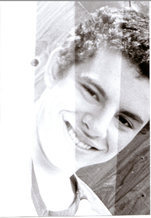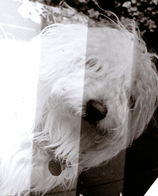MAKING A TEST STRIP
A test strip is used to determine the correct exposure for a print. Several exposures are made onto the same sheet of paper. This is the only really reliable way to establish exposure. When this is developed, it is easier to see the correct exposure for the print.
- Place a large sheet of opaque card nearby
- Halve a sheet of printing paper - or cut a strip of at least 2 inches wide. Replace the paper in the bag.
- Lay it diagonally across the picture - shiny side up. In a landscape picture, this diagonal strip ensures that the sky and land are included in the assessment.
- Stop down the aperture.
- Switch off the enlarger and allow any vibrations to settle down.
- Switch on the enlarger and expose the whole sheet for 5 seconds - use the timer and concentrate on it.
- Place the opaque card over the sheet and switch on the enlarger again for a further 5 seconds.
- Switch off the enlarger.
- Move the card across a further section (quarter) of the strip.
- Switch on the enlarger and expose for a further 10 seconds - keeping an eye on the timer.
- Switch off the enlarger.
- Move the card across a further section (quarter) of the strip.
- Switch on the enlarger and expose for a further 20 seconds - keeping an eye on the timer.
DEVELOP THE STRIP
- When the strip is dry, examine it closely in normal daylight.
- Work out the exposure time for the best band in the strip.
Exposure times for a test strip are:
- 5 seconds on the overall sheet
- + 5 seconds of one strip
- + 10 seconds of another strip
- + 20 seconds of the final strip
|
Acknowledgement:
Tutor: Peter Perry These notes are an accumulation of those written by myself - or obtained from the College during the course.
This is not a commercial site. |
Polly Healy - Course Work : 2000
SOUTH THAMES COLLEGE, LONDON, SW18 2PP ______________________________________________________ Copyright: THE SMOOTH GUIDE TO PHOTOGRAPHY - How to get started ... [email protected] _____________________________________________________ See other Smooth Guide sites: www.animalsandenglish.com www.englishlanguagetips.com www.smoothguide-mahjong.com www.smoothguide-internetfundamentals.com www.smoothguide-kenyacoast.com www.healyshandyhouseholdhints.com www.smoothguide-sunbury.com |

